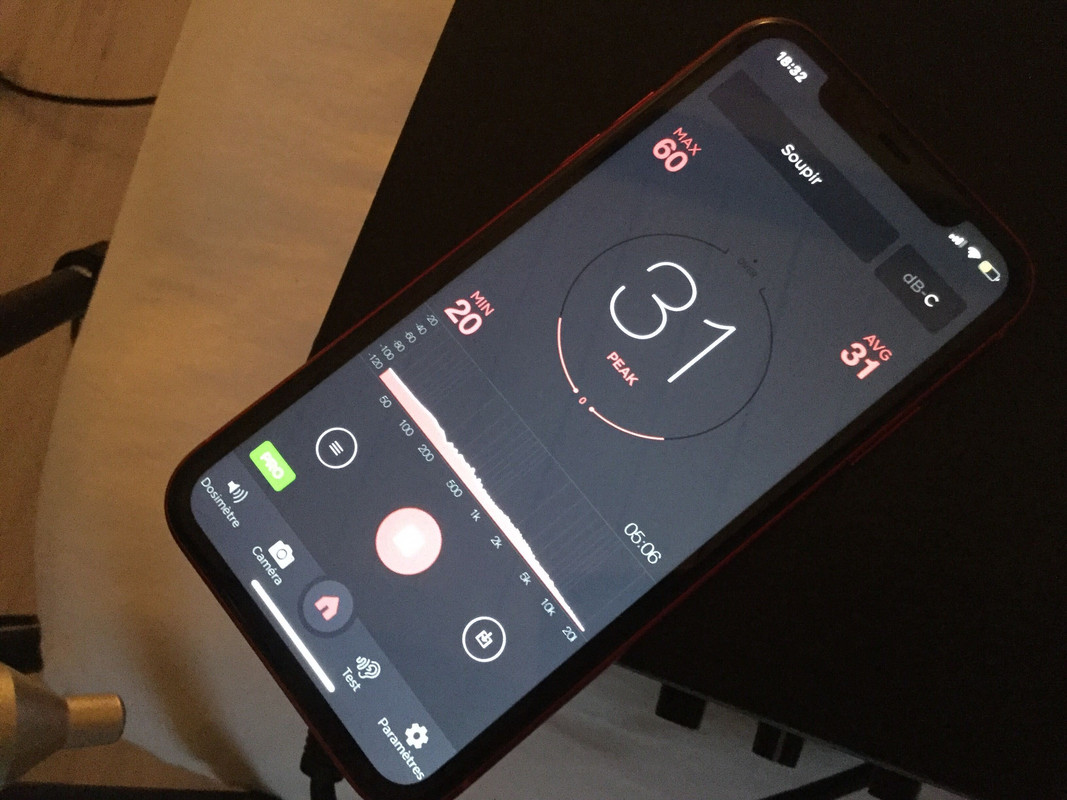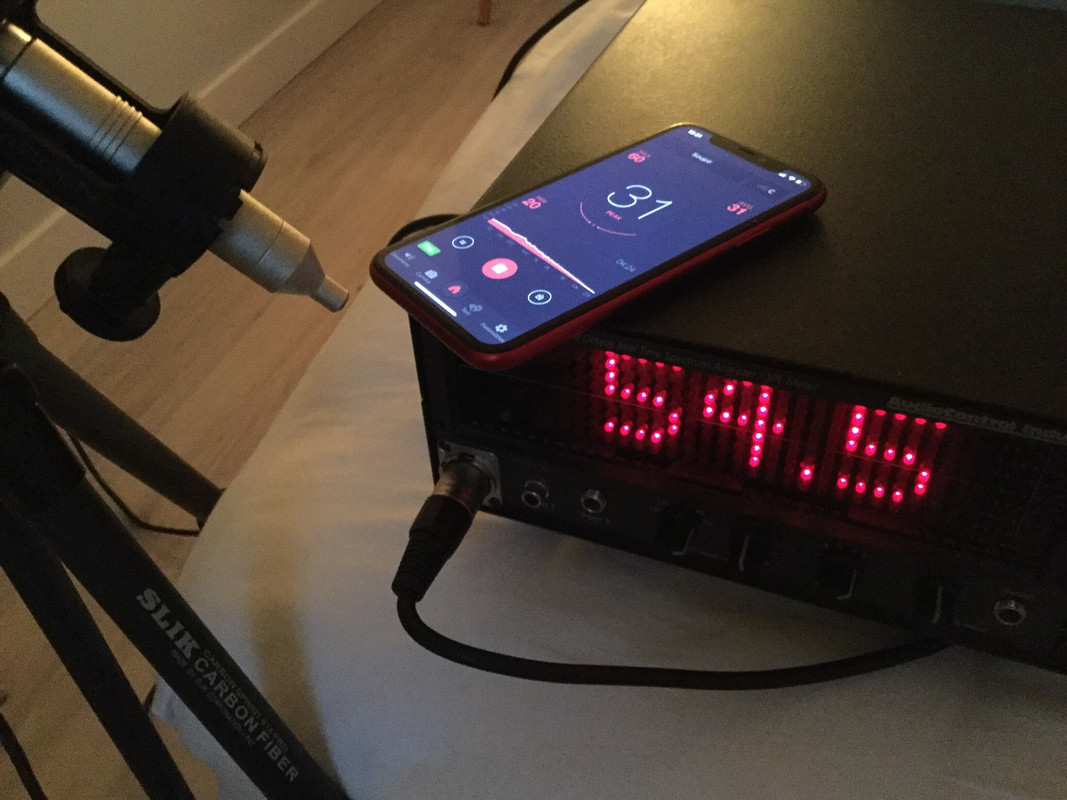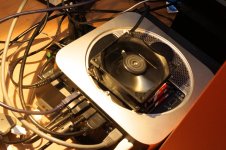A desktop computer can add +20dB noise floor. Extreme care is needed to obtain reference 20-30dB noise floor.
Only electronics in the room was the Apple Macmini, which is very quiet, and the amplifier/DSP, and the RTA, which are dead silent.
Well, if you say Mac Mini is quiet, I have to say you're accustomed to the high noise floor. My Mac Mini is annoyingly noisy in my reference room, so I removed its fan, added large 12V fan running 5V (slow), and put it on the huge heatsink, and it is still somewhat annoying.
In 20dB room, the loudest noise you hear should be your blood circulating noise in your head.
In 20dB room, the loudest noise you hear should be your blood circulating noise in your head.
Ok, I made an error.
But it's good news. For me. And the test. 😛
Here is some self-explanatory images:



So for some reasons, I took it for granted that my Audio Control Industrial RTA (and my calibrated mic) was able to measure the noise floor. It's good for high SPL (142db I think?) but not for low SPL...
SO, my bedroom reads on the iPhone app dB meter a average of 31db with C-weighting while my RTA reads 54.5db.
Also, as you can see, with A-weighting it's 24db while the RTA reads the same 54.5db.
But let's use the C-weighting since it's more appropriate I believe.
Therefore, my RTA measured an average of 52.5db in the room so the real C-weighting noise floor was 29db.
Post #1 updated.
Thank you Plasmu. 🙂
But it's good news. For me. And the test. 😛
Here is some self-explanatory images:



So for some reasons, I took it for granted that my Audio Control Industrial RTA (and my calibrated mic) was able to measure the noise floor. It's good for high SPL (142db I think?) but not for low SPL...
SO, my bedroom reads on the iPhone app dB meter a average of 31db with C-weighting while my RTA reads 54.5db.
Also, as you can see, with A-weighting it's 24db while the RTA reads the same 54.5db.
But let's use the C-weighting since it's more appropriate I believe.
Therefore, my RTA measured an average of 52.5db in the room so the real C-weighting noise floor was 29db.
Post #1 updated.
Thank you Plasmu. 🙂
29db C-weighted noise floor and 22db A-weighted noise floor.
Told you it was quiet. Quiet enough to NOT hear differences in the drivers... ;-)
Told you it was quiet. Quiet enough to NOT hear differences in the drivers... ;-)
In 20dB room, the loudest noise you hear should be your blood circulating noise in your head.
20db room, A-weighted, B or C or Z ?
It's pretty obvious and completely logical.
If you don't conduct an identical 'before' test you can't be sure what factor is responsible for the results obtained from the listening subjects. You assume it's the bandpass filter implemented in the miniDSP. But you don't know that for sure
Maybe it's cabinets the drivers are mounted in, or the cheap D-class amp with poor harmonic distortion specs that you are using, or lousy MP3 source files, or something else. The point is that you don't know, because you haven't eliminated all of the other possible causes. The only way to do that is to run an identical 'before' test, which you apparently you did not do.
You also should have run and provided for us full FR graphs with a microphone located at the listeners head position. Those also should have been done both before and after the filtering was added with miniDSP.
You apparently did not do any of that, or if you did, you haven't reported it.
Without that data and the 'before' ABX test results your conclusions lack any merit and remain useless.
Ok I better understand what you are trying to explain. Thank you for that.
Here is my comments about it:
1. The bandpass filter was mandatory, not optional. Different drivers, limited mechanical capacities. While I can let few of them unfiltered, a driver like a FR10 or even worst a 950PB, couldnt take lower frequencies in the 90-95db range...
2. Bandpass filter was, obviously, needed also to compare apples and apples, and putting a 950PB against a 10'', fullrange, would have been silly. The 360hz-7200hz was determined in pre-testing phase, and it was the maximum possible within each driver's limits.
3. Feel free to question the quality of the miniDSP nanoDIGI, or the 50asx2 ICEpower amplifier, or basically anything you want... But I don't. Previous blindtests showed that electronics and cables -if in good working order and appropriate for the task- are also indistinguishable.
That being said, if you have a tube amplifier with a roll-off north of 17khz, by example, YES, we might spot it. But then again, that's not the ICEpower's fault. It's that tube amplifier that is not appropriate for Hi-Fi.
Last edited:
Great, I think that's a reasonable number. I actually thought it was a typo when I saw 52.5dB. 30dB is not bad. You still have 50dB dynamic range which is not ideal, but acceptable IMO.
BUT, I'm still skeptical about your test for the rest of the reasons including RT60 and early reflection, and I don't even start talking about mental bias and ABX test.
350ms is long for critical listening in this size of the room, and it is probably measured only at 1K or so. Also it seems you did not treat early reflection at all, if I'm correct. We at least need a ceiling cloud or such for nearfield critical listening, and diffusers optional. Do you have a picture of the testing room?
BUT, I'm still skeptical about your test for the rest of the reasons including RT60 and early reflection, and I don't even start talking about mental bias and ABX test.
350ms is long for critical listening in this size of the room, and it is probably measured only at 1K or so. Also it seems you did not treat early reflection at all, if I'm correct. We at least need a ceiling cloud or such for nearfield critical listening, and diffusers optional. Do you have a picture of the testing room?
Based on numerous comments I have here, I think few people are not quite grasping the whole idea of these types of blind tests...
There is common environment. There is common equipment. There is common music excerpts.
The variable left, is the drivers.
The listener sits on a chair. He stays still on a chair. On-axis.
Then, he listens to a music excerpt. At a fixed SPL. On driver A, then driver B.
THE ONLY THING THAT CHANGES HERE, are the drivers.
Common room, equipment, listener, room temperature, you name it. It's COMMON for all drivers. Anchored. All of them.
Bottomline, if a piece of equipment affects, in any way, a driver.... ALL others will be affected.
The only valid argument, in that regards, would be IF a piece of equipement, or the room, or the music excerpt, or anything, is SO unfit for the task, that it ruins everything for all drivers. In the most perfect even way.
Which I doubt, HIGHLY. To say the least.
There is common environment. There is common equipment. There is common music excerpts.
The variable left, is the drivers.
The listener sits on a chair. He stays still on a chair. On-axis.
Then, he listens to a music excerpt. At a fixed SPL. On driver A, then driver B.
THE ONLY THING THAT CHANGES HERE, are the drivers.
Common room, equipment, listener, room temperature, you name it. It's COMMON for all drivers. Anchored. All of them.
Bottomline, if a piece of equipment affects, in any way, a driver.... ALL others will be affected.
The only valid argument, in that regards, would be IF a piece of equipement, or the room, or the music excerpt, or anything, is SO unfit for the task, that it ruins everything for all drivers. In the most perfect even way.
Which I doubt, HIGHLY. To say the least.
20db room, A-weighted, B or C or Z ?
I honestly don't know, and I don't even remember exact number as I said. When I built this room, a friend of mine measured it.
Great, I think that's a reasonable number. I actually thought it was a typo when I saw 52.5dB. 30dB is not bad. You still have 50dB dynamic range which is not ideal, but acceptable IMO.
BUT, I'm still skeptical about your test for the rest of the reasons including RT60 and early reflection, and I don't even start talking about mental bias and ABX test.
350ms is long for critical listening in this size of the room, and it is probably measured only at 1K or so. Also it seems you did not treat early reflection at all, if I'm correct. We at least need a ceiling cloud or such for nearfield critical listening, and diffusers optional. Do you have a picture of the testing room?
29db noisefloor and music was sometimes at 95db, so that's a 66db dynamic range. That's plenty. Especially for this kind of test that was made to mimic normal HiFi conditions... Same for the RT60.
I know a LOT of audiophiles who enjoy RT60 north of 700-800ms....
In fact, myself, I wouldnt want my living room to be 150ms or something in that region...
I honestly don't know, and I don't even remember exact number as I said. When I built this room, a friend of mine measured it.
The weighting is very important.
In fact, myself, I wouldnt want my living room to be 150ms or something in that region...
Of course. I'm talking about a critical listening environment, not a casual listening environment.
29db noisefloor and music was sometimes at 95db, so that's a 66db dynamic range.
Oh well, there is another potential issue I find, but I would not go into it now because I have to go... Maybe I can come back tomorrow. Enjoy evening. 🙂
Neil DeGrasse Tyson "Human perceptions is rife with always getting it wrong. We are poor data taking devices, that's we have such a thing as science, because we have machines that don't care what side of the bed they woke up in the morning, didn't care what they said to their spouse that day, doesn't care if they had their morning caffeine, they'll get the data right."
I prefer the data & cold hard "inhumane" facts. Jon Bocani is fighting an entire industry in this endeavour, daring to say, The technology has already exceeded our human hearing capabilities...and every other endeavours to improve our technology for our benefits in hearing is pointless.
--------------------------------------------------------------------Rick.........
I prefer the data & cold hard "inhumane" facts. Jon Bocani is fighting an entire industry in this endeavour, daring to say, The technology has already exceeded our human hearing capabilities...and every other endeavours to improve our technology for our benefits in hearing is pointless.
--------------------------------------------------------------------Rick.........
Of course. I'm talking about a critical listening environment, not a casual listening environment.
I don't think going from 350ms to 150ms would have change anything in the results.
In fact, it might be the exact opposite: a very high RT60 room might have affected the behavior of the drivers, because of the power response, in a way that we could have made them identifiable. But then again, the whole room and set-up was made to mimic real life hifi.
Haven't read the whole thread but just wanted to add my .2
Since I started using a receiver with Audyssey room eq I find that many speakers I set up in my living room end up sounding more or less the same. What I notice now are the differences in dynamics (sensitivity), directivity, and diffraction. It's incredible the difference that cabinet diffraction makes between a speaker that disappears to one that doesn't.
Mind you there's still something about metal tweeters that makes me want to turn it off after a while.
Since I started using a receiver with Audyssey room eq I find that many speakers I set up in my living room end up sounding more or less the same. What I notice now are the differences in dynamics (sensitivity), directivity, and diffraction. It's incredible the difference that cabinet diffraction makes between a speaker that disappears to one that doesn't.
Mind you there's still something about metal tweeters that makes me want to turn it off after a while.
Jon Bocani is fighting an entire industry in this endeavour, daring to say, The technology has already exceeded our human hearing capabilities...and every other endeavours to improve our technology for our benefits in hearing is pointless.
Thank you Richard, it's nice to see that some people here understands that very logic.
I think many many things are, indeed, exceeding (by far) our hearing capabilites.
The whole music industry, with their quest to sell 24/96 or 24/192 music files (not for studio, but for the customers) is totally absurd. Pretty much like a 100mpx camera on a phone, with a tiny lense. Pointless. Entirely. Almost a fraud, in fact. Compressed MP3's and AAC are undistinguishable from their HD uncompressed counterpart.
Amplifiers? Nobody here could spot class-D amps I use from a Class A or Class AB that could cost 100k... unless the FR is not flat.
Cables? A joke for decades. A total humiliation for the audiophile world. If ''normal'' people are seeing us as cou-cou, it's because of cables.
D/A converters: I thought audible differences would exist, but no. Only in our imagination. The wonderful magic of psychoacoustic strikes again.
And now, transducers... Ouch. That was painful, though. But it's time to wake up, folks. Time to focus on what counts: FR, of course, room's acoustic, undistorted SPL for dynamic range...
But most of the rest? Let's just say ''No more.''
Haven't read the whole thread but just wanted to add my .2
Since I started using a receiver with Audyssey room eq I find that many speakers I set up in my living room end up sounding more or less the same. What I notice now are the differences in dynamics (sensitivity), directivity, and diffraction. It's incredible the difference that cabinet diffraction makes between a speaker that disappears to one that doesn't.
Mind you there's still something about metal tweeters that makes me want to turn it off after a while.
Brad, there is indeed chances that TWEETERS might be identifiable in a blindtest. I wouldnt bet on that, but I think there is chances. Even carefully EQ / SPL matched.
- Status
- Not open for further replies.
- Home
- Loudspeakers
- Multi-Way
- BLINDTEST: Midrange 360-7200hz, NO audible difference whatsover.
